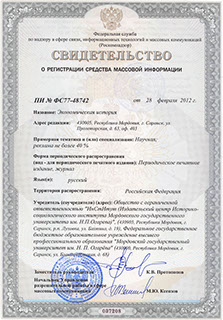Экономическая историЯ
Russian Journal of Economic History
ISSN 2409-630X (Print)
ISSN 2618-916X (Online)
Expert board:
- Scientific Council of RAS on economic history;
- Research and Educational Center «The economic history of Central Russia and the Middle Volga region» of Ogarev Mordovia State University;
- Center of Economic History of Lomonosov Moscow State University
Navigation
Certificate of registration

ISSN 2409-630X (Print), ISSN 2618-916X (Online)
DOI: 10.15507/2409-630X.058.018.202203.201-210
Alexander A. Rukavishnikov
Nosov Magnitogorsk State Technical University (Magnitogorsk, Russia),
e-mail: alexander585@mail.ru
Solving the Problem of Excess Money Supply During the Post-War Reform of 1947 in the USSR: Methods and Effectiveness
Abstract
Introduction. The article identifies and summarizes ways to solve the problem of excess money supply on the eve and during the monetary reform. Evaluation of the effectiveness of solving this problem was carried out using a wide range of criteria (economic, social, propaganda-psychological, international and military-political). In general, in this aspect, the topic has not been previously studied enough.
Materials and Methods. The study has been carried out on the materials of the central archives, collections of published documents and statistics, as well as on the data of the central periodical press, works and memoirs of the top Soviet leadership. Taking into account the interdisciplinarity of the topic, a set of methods has been involved: general scientific and special scientific. The main methodological principles of this study are historicism, scientific objectivity, consistency, principles of dialectics.
Results. In the course of the study, the issue of the post-war reduction in the money supply and putting money circulation in order has been characterized. When considering the implementation of the monetary reform, the desire of the state to be able to strengthen control over the movement of cash in new money has been traced. The solvent demand of the population was limited, which in turn allowed the state to more easily ensure the saturation of the consumer market. Carrying out the exchange of money, together with the abolition of the card system and the reduction in retail prices, mitigated the negative social effect from the loss of part of the savings by the population.
Discussion and Conclusion. Before the monetary reform, measures were taken to withdraw money from circulation. As a result of the reform, the cash supply decreased by more than three times. It can be seen from the survey data that, having carried out exchange measures, the state was in no hurry to immediately issue a sufficient amount of new money into circulation, leaving room for maneuver to regulate the volume of money supply. Despite the obvious confiscatory and contradictory nature of the monetary reform, it can be stated that its main financial and economic goal was achieved – it was possible to successfully solve the problem of post-war stabilization of monetary circulation and ensure the transition to a stable peaceful economy.
Keywords: monetary reform, post-war reform, money exchange, Soviet finance, money circulation, money supply, USSR.
For citation: Rukavishnikov A. A. Solving the problem of excess money supply during the post-war reform of 1947 in the USSR: methods and effectiveness. Ekonomicheskaya istoriya = Russian Journal of Economic History. 2022; 18(3): 201–210. (In Russ.). DOI: 10.15507/2409-630X.058.018.202203.201-210.
© Ogarev Mordovia State University. History and Sociology Institute, 2017
68, Of. 411, Bolshevistskaya St., 430005, The editorial office of the scholarly journal «Russian Journal of Economic History»
Tel.: (8342) 24-25-90; 27-07-11, Fax: (8342) 24-25-90, E-mail: jurnal-econom-hist@isi.mrsu.ru
Designed by A. Napalkov, Email: napalkov@isi.mrsu.ru

